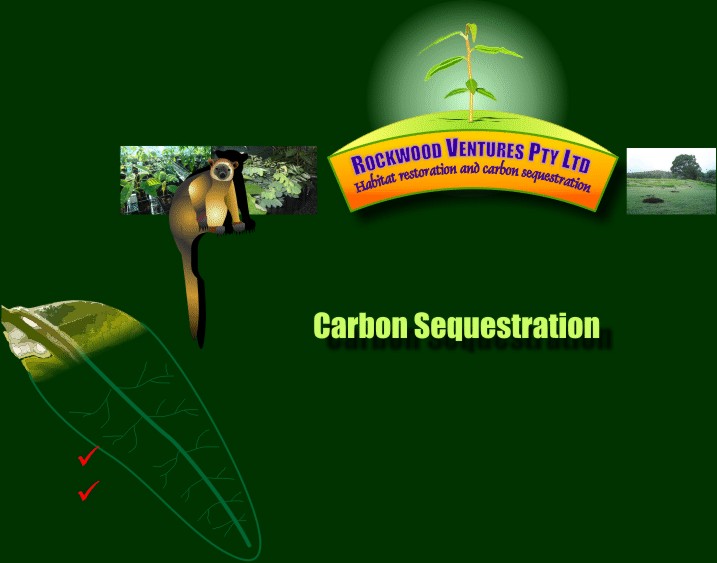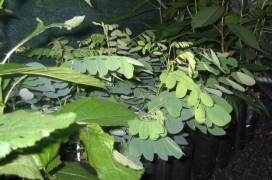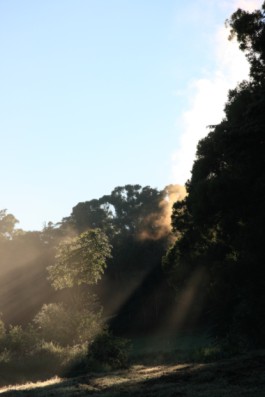




Indian rosewood (Dalbergia latifolia) hardening off in the shadehouse




No single action or technology will solve the problem and the longer we delay, the greater the impact will become. We must, therefore, use every option available to us now to tackle what is emerging as our greatest challenge. This is where forestry becomes extremely important.

The proverbial edge of the forest, with the tropical sun beginning to bake the adjacent paddock - a paddock ripe for forestry
One of the few factors in man-kind's favour for the mitigation of anthropogenic (man-made) climate change is that GHGs don't have to be captured at source – the very nature of the problem is global! A portion of the emissions from a coal-powered generator in the Latrobe valley, can be – is – sequestered in the Amazon rainforest.
Millions of dollars and man-hours are being expended on research across multiple industries to develop carbon sequestration technologies, yet for all our intellect and advanced technology, a simple cost-effective solution for carbon capture and storage eludes us. It seems there is unlikely to be a magical future cure and we cannot afford to wait for one: the magnitude of the climate challenge mandates that all safe methods at our disposal must be used concurrently and as soon as possible. Interestingly, we expend relatively little on implementing the one solution that already exists, literally at our finger-tips, and has been tried and tested globally over hundreds of millions of years. Forests...
When you hold a tree seed in your hand it is a most remarkable thing. Each tiny seed is capable of being transported by wind, beast or water. Within the seed lies the genetic engineering blueprints and raw materials — wrought from millions of years of development in nature's evolutionary biology lab — to build a self-replicating, solar-powered carbon capture and storage factory. Furthermore, the factory can be
dismantled and its component parts used to construct myriad products useful to man; some of which can continue to sequester the carbon for centuries. Meanwhile the site of the original factory is now preconditioned in terms of soil health and competitive weed mitigation for the next solar-powered carbon sequestration factory to be installed.
Emissions Reduction: Self-replicating Solar-powered Carbon Capture and Storage Factories
At the top of this page, we described the second concurrent strategy for tackling climate change, the reduction of contemporary emissions. One of the most significant advantages of sequestering carbon in timber is that production of the resource generates minimal GHGs — the factory is after all, solar powered! Many of the construction products and other products for which timber is an alternative, generate significant GHG's during their production[1]. Consider, for example, the emissions associated with the production of steel construction beams. The mining and shipment of the iron ore alone requires enormous energy. Add to that the burning of coking coal and other energy requirements in the smelting process, and the cost to the climate is significant. Meanwhile, an equivalent timber beam will have emitted minimal GHG's through the harvesting and milling process and will sequester 50% by weight of carbon within its structure. It could be further argued that tools required to work with the alternative materials for the beams on a construction site will be similarly greenhouse friendly in favour of the timber beam. Finally, the architectural result will be much more aesthetically appealing rendered in timber – though this view is rooted squarely in the eye of the beholder.
Forest Emissions: Dispelling the Myth
Many discussions about carbon sequestration in forests invariably come around to the subject of the GHGs emitted by forests as part of their natural processes. The principal source being cited is the rotting of organic matter on the forest floor. These gains and losses of GHGs are referred to as fluxes and their measurement is one of the central concerns of climate science. In dealing with this myth, let us first consider the forest in question from the point of view of land use, land use change and forestry (LULUCF). In simple terms, a tree is comprised of roughly 50% by dry weight of carbon [2]. When you consider that trees grow roughly equally above and below the ground, it follows that the volume of carbon within a forest is substantial. Add to this the carbon tied up in the biomass that inhabits the soil around the root zone and the amount of carbon sequestered by a forest increases still further. Now if all of this carbon-sequestering organic material (potentially measuring 50m from deepest root to tallest limb) has replaced a shallow rooted grassland, the thickening of the biosphere is 50-fold. No quantitative measurements are required to see that Land Use Change (afforestation or reforestation from grassland to forestry) is significantly carbon positive. In fact, carbon fluxes have been measured in old growth forest within the Amazon and other areas, and it has been established that even in stable forest, where everything should be in equilibrium, there is a net positive gain of carbon – that is, the forest sequesters more carbon than it leaks [3]. Finally, even if the forest were in a state of equilibrium, if we were to remove timber from the forest using sustainable forestry practices, the carbon sequestered within the timber and the emissions avoided for production of an alternative product as discussed above will still see significant net carbon sequestration.
Our Vision
An approach is required that sees these natural carbon sequestration factories established on a broad scale by individuals, organisations and corporations alike. Altruism alone does not provide the incentive for this to occur. However, the Continuous Cover Forestry model we propose, coupled with a number of other initiatives we are pursuing, may well make the economic difference to see a rapid expansion of forest cover. In time, it is hoped that the insight we are gaining will be available to others as an education package, supported by the tools, infrastructure and markets of a growing industry. And that this will contribute significantly to the security of future generations in the fight to slow down climate change.
References
[1] – Burley, J., Ebeling, J. and Costa, P.M. (2007). Carbon Sequestration as a Forestry Opportunity in a Changing Climate. Forestry and Climate Change, pp31–37
[2] – Buchanan, A.H. and Levine, S.B. (1999) Wood-based building materials and atmospheric carbon dioxide. Environmental Science and Policy 2, pp427–437
[3] – Jarvis, P.G. and Linder, S. Forests remove carbon dioxide from the atmosphere: spruce forest tales! Forestry and Climate Change, pp60-75
Forestry has long been perceived as a blight against the environment, and this perception is valid where forestry has been conducted as clear-fell of natural forests, or the establishment of exotic monocultures to create ecological wastelands. But the time is now right to rebuild what we have destroyed, and sequester vast amounts of carbon in so doing. By conducting Continuous Cover Forestry, by reforesting with an eye to habitat, to biodiversity and biological soil health, we can have truly sustainable forestry that actually expands the land under canopy. Furthermore, when we choose forest products over less GHG-efficient alternatives, not only will we be sequestering carbon directly within the product, but we will be reducing significantly more emissions through abatement, the emissions that would have been generated for the less efficient production of an alternative. An excellent graphical representation of this vision can be seen at our US affiliate company’s website.
Forests: Self-replicating Solar-powered Carbon Capture and Storage Factories
Tackling the Climate Challenge
As for reducing our emissions, this requires lifestyle changes and active choices by every government, individual and business on the planet to opt for emissions-friendly alternatives in place of other – often more convenient or economical – products and services. This concept lies at the heart of the carbon economy which indexes everything against its real cost for a sustainable climate. When you consider the ‘real cost’ economics, it seems a prudent choice, rather than leveraging (or borrowing) from the future. The present economic climate provides an ideal opportunity to instigate the so-called ‘green economy’ as we rethink and restructure our economic mechanisms.
Firstly, sequestering (capturing and storing) past emissions, and
Secondly, reducing contemporary emissions from all sources [1].
While these actions may appear straightforward, the devil lies in the detail. Capturing and storing carbon and other GHGs must be done in an energy efficient manner to avoid contributing more emissions than we are trying sequester in the first place. Furthermore, the storage system must minimise leakage, especially where there is potential for a single event to release dangerous volumes of concentrated GHGs.
The challenge of reducing the percentage of green house gases (GHGs) in the Earth's atmosphere requires two relatively straightforward strategies:









